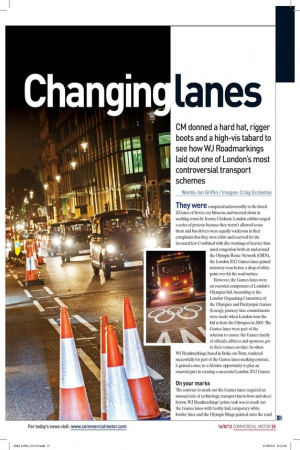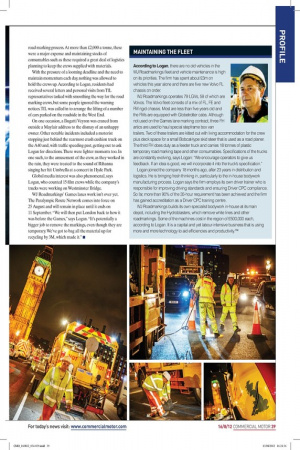Changing lanes
Page 26

Page 27

Page 29

Page 30

If you've noticed an error in this article please click here to report it so we can fix it.
CM donned a hard hat, rigger boots and a high-vis tabard to see how WJ Roadmarkings laid out one of London’s most controversial transport schemes
Words: Ian Griffin / Images: Craig Eccleston They were compared unfavourably to the hated Zil lanes of Soviet-era Moscow, and tweeted about in scathing terms by Jeremy Clarkson. London cabbies staged a series of protests because they weren’t allowed to use them and bus drivers were equally vociferous in their complaints that they were elitist and reserved for the favoured few. Combined with dire warnings of heavier than
usual congestion both on and around the Olympic Route Network (ORN), the London 2012 Games lanes gained notoriety even before a drop of white paint ever hit the road surface.
However, the Games lanes were an essential component of London’s Olympics bid. According to the London Organising Committee of the Olympics and Paralympic Games (Locog), journey time commitments were made when London won the bid to host the Olympics in 2005. The Games lanes were part of the solution to ensure the Games family of oficials, athletes and sponsors, got to their venues on time. So when WJ Roadmarkings, based in Stoke-on-Trent, tendered successfully for part of the Games lanes marking contract, it gained a once-in-a-lifetime opportunity to play an essential part in creating a successful London 2012 Games.
On your marks
The contract to mark out the Games lanes required an unusual mix of technology, transport know-how and sheer brawn. WJ Roadmarkings’ prime task was to mark out the Games lanes with freshly laid, temporary white border lines and the Olympic Rings painted onto the road surface at regular intervals by way of identifying marks.
With just a four-week window to lay down about 80 miles of temporary tape, and paint somewhere in the region of 15 miles of white lines and thousands of Olympic Rings, WJ Roadmarkings worked closely with Transport for London (TfL) and other contractors to plan the whole Games lanes marking programme as carefully as any military operation.
Over a four-week period before the Games lanes went live on 25 July (they were decommissioned on 15 August), they worked from Wembley to Wimbledon, to the Horse Guards Parade to Greenwich Park, as well as at the Olympic Village itself. The strict timings and deadlines on the contract called for careful planning, as 35 Volvo trucks and numerous pickups and minibuses were used by WJ Roadmarkings alone to fulil its part of the workload.
A secure yard was created as a holding pen and operational stores off Cortina Drive on the old Ford works site at Dagenham. In addition to mobile buildings and facilities for the drivers and machine operators, the yard master also maintained a stock of gas bottles, tape, paint and relective beads for the white lines here.
No stone left unturned
Nothing was left to chance. WJ Roadmarkings even bought its own tyre itter with it from Stoke-on-Trent. During the four-week period, there were only two punctures and one tyre was replaced because of a fault.
Vehicle maintenance was carried out during the day by the company’s own technicians with rigorous inspections of each truck before it went to work every night at 6pm.
Although WJ Roadmarkings’ leet includes some Daf, Scania and more recently, MAN content, Volvo is the preferred make of chassis. “This is because of their reliability,” says transport manager Scott Logan. Volvo was the irst make operated by the business owners and directors when they started out 25 years ago.
A total of 35 Volvos were used on the Games lane
contract, including three Hydroblasters (Volvo sixand ▲ A total of 35 Volvos eight-wheel chassis-mounted needle water jet-powered were used on the Games surface removers that operate at 40,000 psi – enough to lane contract
cut through steel), and WJ Roadmarkings had only one minor problem during the period. “An FL used on low speed work had to go to the local dealer, MC Truck and Bus, when its clutch began slipping,” says Logan.
“The Volvo dealer was really helpful. We took the truck in at 11:30am and it was back with a new clutch by 5pm, and we paid the same parts price as the deal we have in Stoke-on-Trent. Apart from a few bulbs and other bits and bobs, that’s the only problem we had in four weeks.” In addition to the trucks, a number of pick-ups and 17-seater minibuses had to be hired in. At irst, it was hoped that these would be available through Londonbased hire companies. Not so, says Logan. “We ended up using a local hire company in the Potteries. They pulled in 13 end-of-contract vehicles at very short notice. We only had one-and-a-half days to kit them out with beacons and highways maintenance marker boards, but we all jumped on it and managed to get them on the road and working inside the deadline.”
Overcoming hurdles
The weather was the biggest challenge during the job, says Logan. The WJ Roadmarkings crews were hampered by torrential rain throughout the four weeks. “We lost three days initially because of the rain, but recovered our position through everybody working lat out for longer hours.” TfL supplied weather radar updates for the London area – which thankfully were accurate, as the crews were in continual danger of being washed away by the rain.
With the Games lanes opening on 25 July, 18-hour days were not unheard of in the race against the clock.
With all the crews staying at a hotel in Rainham and working nights for the four-week period, a typical working day started at 6pm or earlier. With everyone assembled at the yard in Dagenham, operations director Martin Webb handed out the job packs to the supervisors for each crew. All the planning was done by a team of WJ Roadmarkings people working from an ofice in Westminster and in touch with the TfL control room in Southwark, as well as the police. WJ Roadmarkings’ people had visited each section in advance and marked out where the Olympic Rings and the white lines were to go. Lane closures would become effective at 9pm and the time between was used to get the convoy of 35 trucks and their crews to their sections, ready to begin work as soon as the go ahead was given by TfL.
TfL was reluctant to close roads completely while the markings were done, so the crews worked in close proximity to live trafic. However, they were protected by crash cushion trucks at the front and rear of each section they were working on. TfL also kept the crews under close scrutiny using CCTV, and safe-working practices were paramount. Non-compliance by any team member meant the whole crew could be ined.
Once the trafic management crash cushion trucks were in place, work would begin on removing existing lines and laying down the temporary black tape before ixing the white lines and spraying the Olympic Rings and lane direction instructions.
Winning team
In the four weeks, WJ Roadmarkings successfully laid down about 80 miles of temporary tape, and painted some 15 miles of white lines and thousands of Olympic Rings. For the latter, it used an in-house designed plastic template system devised by Webb. As it was a rigid, folding template, it proved both portable and eficient compared with the solutions used by other contractors, which required masking tape to be applied on the road before spraying was carried out.
Relective beads were added to the paint used in the road marking process. At more than £2,000 a tonne, these were a major expense and maintaining stocks of consumables such as these required a great deal of logistics planning to keep the crews supplied with materials.
With the pressure of a looming deadline and the need to maintain momentum each day, nothing was allowed to hold the crews up. According to Logan, residents had received several letters and personal visits from TfL representatives tasked with smoothing the way for the road marking crews, but some people ignored the warning notices. TfL was called in to arrange the lifting of a number of cars parked on the roadside in the West End.
On one occasion, a Bugatti Veyron was craned from outside a Mayfair address to the dismay of an unhappy owner. Other notable incidents included a motorist stopping just behind the rearmost crash cushion truck on the A40 and, with trafic speeding past, getting out to ask Logan for directions. There were lighter moments too. In one such, to the amusement of the crew, as they worked in the rain, they were treated to the sound of Rihanna singing her hit Umbrella at a concert in Hyde Park.
Global media interest was also phenomenal, says Logan, who counted 15 ilm crews while the company’s trucks were working on Westminster Bridge.
WJ Roadmarkings’ Games lanes work isn’t over yet. The Paralympic Route Network comes into force on 25 August and will remain in place until it ends on 11 September. “We will then put London back to how it was before the Games,” says Logan. “It’s potentially a bigger job to remove the markings, even though they are temporary. We’ve got to bag all the material up for recycling by 3M, which made it.” ■
MAINTAINING THE FLEET
According to Logan, there are no old vehicles in the WJ Roadmarkings fleet and vehicle maintenance is high on its priorities. The firm has spent about £3m on vehicles this year alone and there are five new Volvo FL chassis on order.
WJ Roadmarkings operates 79 LGVs, 59 of which are Volvos. The Volvo fleet consists of a mix of FL, FE and FM rigid chassis. Most are less than five years old and the FMs are equipped with Globetrotter cabs. Although not used on the Games lane marking contract, three FH artics are used to haul special stepframe box van trailers. Two of these trailers are kitted out with living accommodation for the crew plus deck space for a small Bobcat-type skid steer that is used as a road planer. The third FH does duty as a feeder truck and carries 18 tonnes of plastic temporary road marking tape and other consumables. Specifications of the trucks are constantly evolving, says Logan: “We encourage operators to give us feedback. If an idea is good, we will incorporate it into the truck’s specification.” Logan joined the company 18 months ago, after 23 years in distribution and logistics. He is bringing fresh thinking in, particularly to the in-house bodywork manufacturing process. Logan says the firm employs its own driver trainer who is responsible for improving driving standards and ensuring Driver CPC compliance. So far, more than 90% of the 35-hour requirement has been achieved and the firm has gained accreditation as a Driver CPC training centre.
WJ Roadmarkings builds its own specialist bodywork in-house at its main depot, including the Hydroblasters, which remove white lines and other roadmarkings. Some of the machines cost in the region of £500,000 each, according to Logan. It is a capital and yet labour-intensive business that is using more and more technology to aid efficiencies and productivity.TM









































